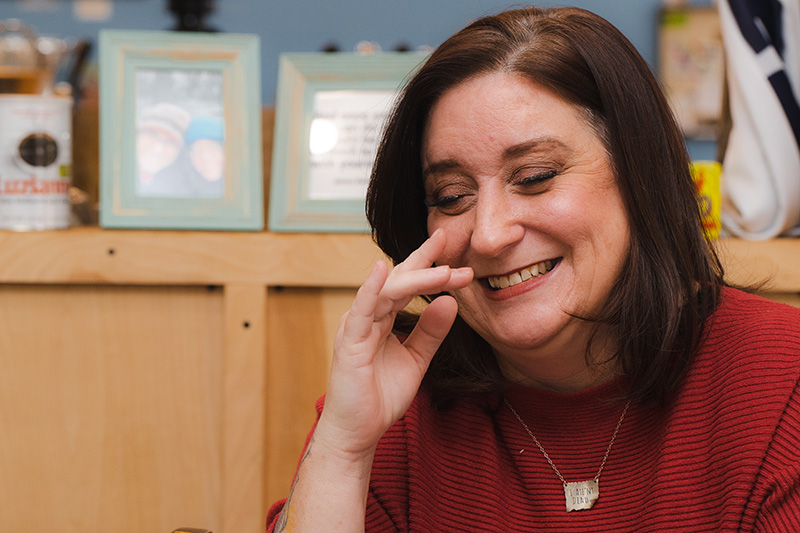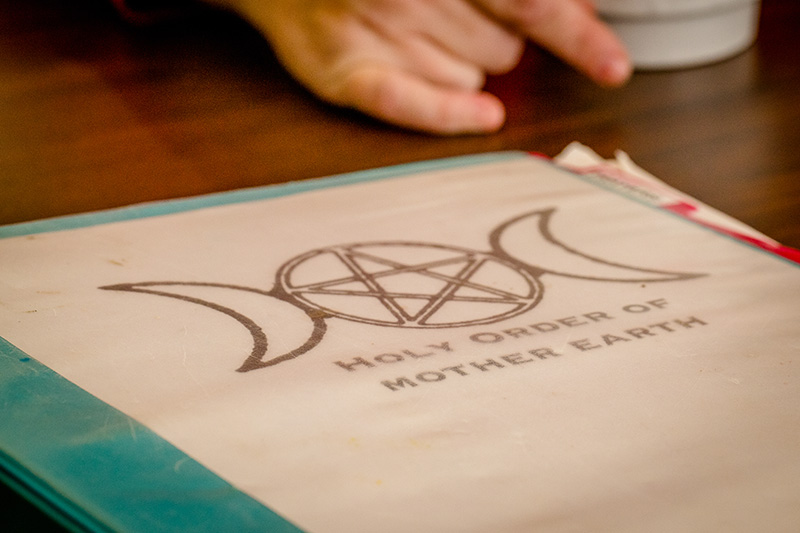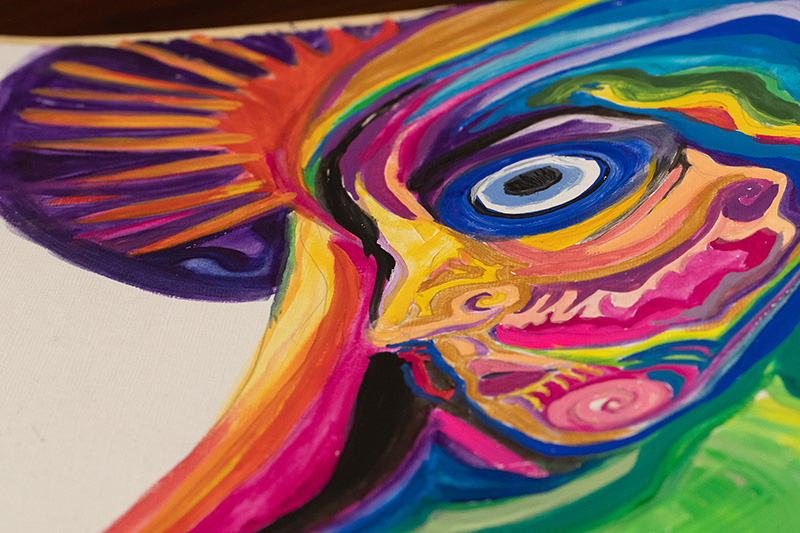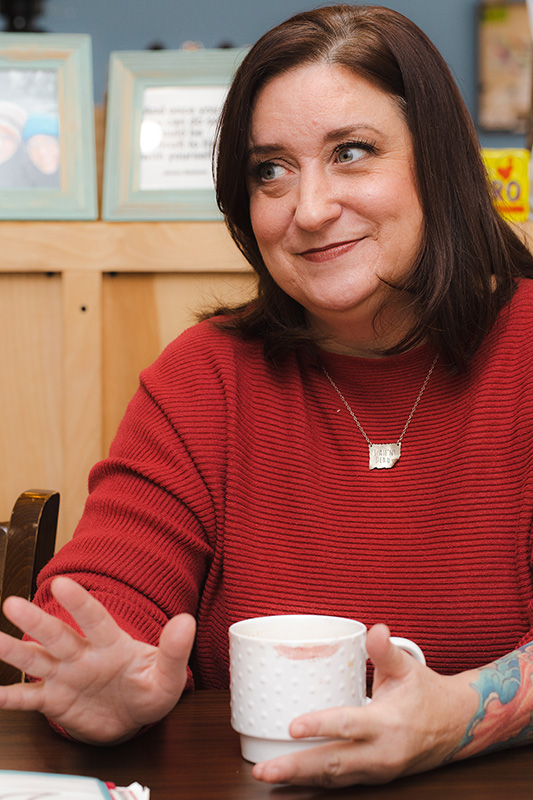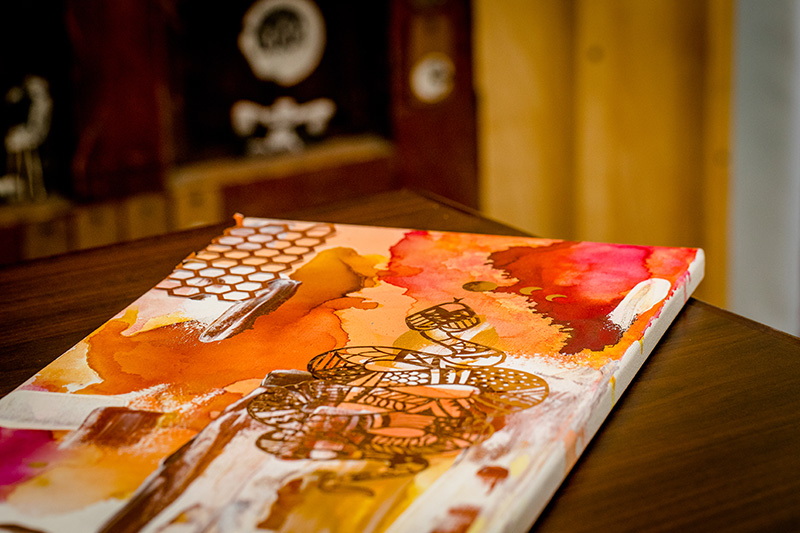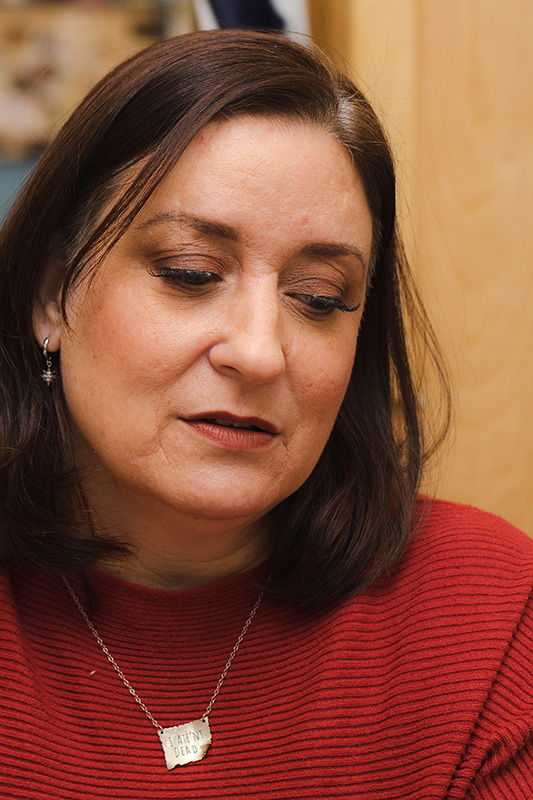My curiosity got the best of me, and I met Holly Hahn.
That’s really how it happened. Holly was the second person in this project that I sort of semi-randomly encountered while taking one of my morning walks in the South End of Columbus (the first being Eli Lambert). I’m curious about a lot of things, and that particular morning, I was curious about a small trash can that hung on the side of the fence near her driveway. There was so much more to notice in that driveway than the trash can, but I had noticed those things before—brightly colored cloths, a mirror, other trinkets—even a unicorn which I photographed at some point. That day it was the trash can full of aluminum cans. After peering into it, and turning to walk away, I heard a voice from the house asking me if there was something she could help me with. We had a pleasant conversation, and then I spied the chickens. What can I say? I simply found it possible to contain my enthusiasm. So now you know. Holly is the woman with the chickens down in Hungarian Village, living in a tucked away house so small that you might miss it if you blinked. There’s one thing you can be certain of, though: five minutes with Holly, and you won’t miss her!
Her story is unusual, even by a creative’s standards (at least it is to me). Her unique relationship with art, spirituality, and her world is worth considering. Even before I got to know her very much, I had a sense that this was the case, and so I was quite pleased that she accepted my invitation to be part of the project.
As a child, Holly’s relationship with art (and other creative endeavors) in general was discouraged. At a young age, she already knew that she wanted to be a makeup artist, but her father’s response was, “we hope you can do something better than that. You’re good with words. You’re going to be a doctor or a lawyer.” The message she received growing up was that art was something that people who had that talent just did, not taking into consideration artistic process or acquisition of skill. She secretly painted with dime store watercolors and cheap paper, but was always ashamed of her work and threw it away. A neurological condition which prevented her left eye from focusing correctly, along with undiagnosed autism, created barriers for Holly in the pursuit of a creative life. In spite of being expelled from High School, she received her G.E.D., and went on to complete a program in Religious Studies at OSU. As she embarked on her twenties, however, a pivotal event became the catalyst for change.
When Holly was 21, she was in a car accident that left her with broken bones and a large scar across her face. “I kind of see my scar as being the difference between…that broke all of those connections to my parents’ expectations. After that happened, there was just no way that my life was going to be what they thought it was going to be. I don’t think I was a very nice person before then; but maybe I just grew a frontal lobe when I was 21.” Holly went on to pursue a creative lifestyle, becoming a licensed esthetician in both Ohio and the State of Washington. In addition to that, she did pursue more “wordy” creative outlets, such as acting, standup comedy, and spoken poetry. Her creative activities have also included performing burlesque, and roller derby.
Around the age of 40, Holly had a sort of meltdown, from which she did not quickly recover. Later on, she would understand this as being related to autism, but at the time she didn’t know what was the cause of her long-term burnout. Her life basically fell apart, and she ended up moving to the west coast; it was in California that she received her diagnosis. She also began to explore painting. Holly reflected that as she began to learn how to paint, there was something an artist said to her that changed her whole life: “You can have talent, and that’s fine, but that’s the vision. Skill is the art of putting it down on paper, and that can be learned.” That encouragement helped Holly to begin to strive less for success, and instead give herself space to create.
Of all of Holly’s work, her writing is most central, and carries the most weight. Any art that she produces is like a gateway to her writing, and is central to her calling as a minister. In 1996, Holly became ordained; Since 1994, she has had a vision of creating a community modeled after the Beguines, a 12th and 13th-century community of women, living primarily in the Low Countries of Europe. Holly has a total of four binders full of writing that contains her vision for this community. She plans on completing the manuscript (titled, “Hag”) about six months from now. She explained to me that the role of the “Hag,” a word derived from the Greek word hagia, which means holy, is more of a community helper.
Holly has been deeply moved by the work of British writer Terry Pratchett. This painting titled, “Summer Lady,” is inspired by the character of the same name in Pratchett’s novel “Wintersmith.” The media used is alcohol ink, acrylic paint, and cutouts made with a Cricut machine. In the novel, Summer Lady reveals herself, not just as lush, green, and flowering, but also as an arid desert, with venomous serpents and bleached bones.
After completing this painting, Holly had a serpent tattoo (still a work in progress) done on her left arm.
Many of Holly’s paintings contain portraits with halos. The painting, done in gouache, also is perhaps a precursor to an idea for a self-portrait that Holly would like to paint. We discussed the Japanese art of Kintsugi, or repairing a broken vessel by filling the cracks with gold. Holly shared with me a short poem that she wrote about that:
One day they will have metallic tattoo ink
And on that day, I will get every scar tattooed in gold
And every broken bone tattooed in silver
And on that day, I will never need jewelry again
Holly on being creative, and gatekeeping:
“I don’t have to be rich and famous; I just have to keep making art.”
“Other people’s validation has been super scarce in my life, and so I’m not super invested about what other…about clients or credibility, or anything like that.”
“I don’t have to be a great artist to call myself an artist.”
“Being over 40 is so great. I just don’t give a shit anymore!”
As we drew to the end of our time together, I asked Holly if there was one other thing that she would like to share with you all. Her fingers immediately grasped this, a pendant around her neck, which came from England, and was a gift from her girlfriend. The inscription is a quote from one of Terry Pratchett’s most important characters, Granny Weatherwax, and Holly echoed the words as she felt them between her thumb and finger: “I ate’nt dead.” In Pratchett’s work, Granny Weatherwax had the ability of “Borrowing,” or overlaying her mind on the mind of another creature. When she did, she became very still, practically catatonic. In order to dispel confusion, she took to wearing a placard stating, “I ate’nt dead.”
“She’s probably the most important fictional character in my life. She serves her people in a way that I want to serve my community,” Holly reflected. “No matter how many times you think I’m down for the count, all I have to do is get back up again.”
Holly, we see that you ate’nt dead.
